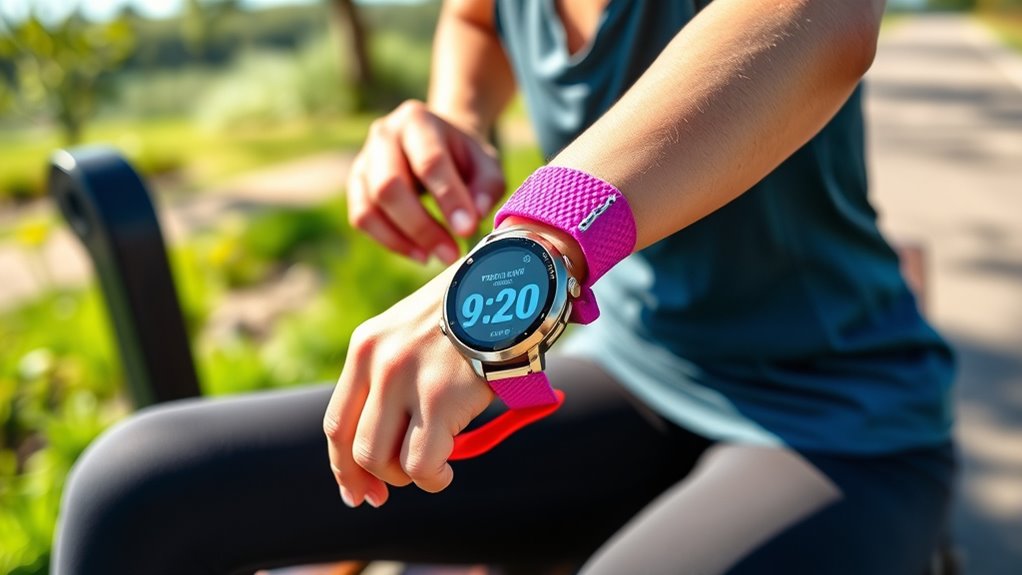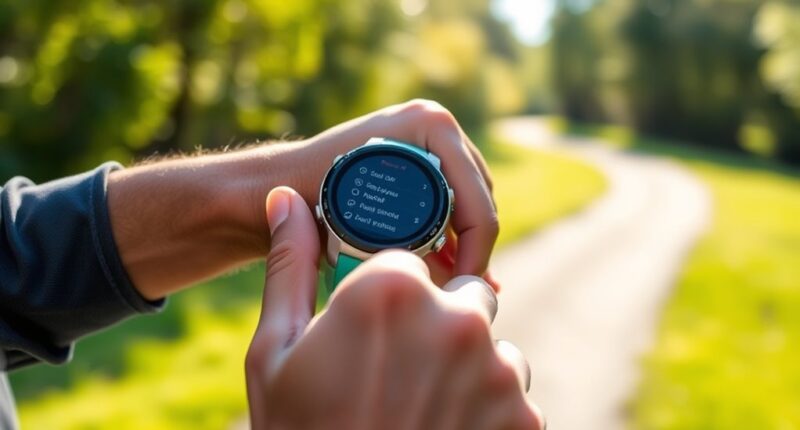To set up your new running watch correctly, start by powering it on and syncing it with your smartphone or computer to transfer data and update firmware. Customize the display and metrics to suit your preferences, then input your personal details like weight, age, and height for accurate tracking. Familiarize yourself with navigation buttons and quick shortcuts for efficient use. Confirm GPS is working outdoors before your workout. Keep these tips in mind to maximize your device’s performance—you’ll find more helpful details as you explore further.
Key Takeaways
- Complete initial setup by syncing your device with your smartphone or computer, ensuring firmware is up to date.
- Customize display metrics and shortcuts to focus on your preferred workout data and quick access features.
- Input personal details like weight, age, and height to enable accurate calorie and training estimations.
- Familiarize yourself with navigation buttons and menu options for efficient operation during runs.
- Test and verify GPS connection outdoors to ensure accurate tracking of distance and pace before starting your workout.

Getting your new running watch ready for your workout starts with a simple setup process. When you first power it on, the initial steps typically involve syncing data, which guarantees your device connects seamlessly with your smartphone or computer. This step is vital because it allows your watch to transfer previous activity records, sync your fitness goals, and update its firmware if needed. Make sure your Bluetooth or Wi-Fi connection is stable, and follow the prompts to pair the device with your app. Once connected, your watch can automatically upload any stored data, giving you a clear picture of past runs and helping you track progress over time.
After syncing data, you’ll want to customize displays to match your workout preferences. Most running watches let you choose which metrics appear on your main screen, such as pace, heart rate, distance, or time elapsed. Customizing displays is straightforward—usually through the device’s companion app or directly on the watch. Spend some time selecting the data points that matter most to you, so during runs, you can glance at your watch and instantly see relevant stats without distraction. This personalization helps you stay focused and motivated, whether you’re tracking your pace, monitoring heart rate zones, or checking calories burned.
Next, take a moment to input your personal details, including weight, age, and height, if the device prompts you. This information helps the watch provide more accurate estimates of calorie burn and training load. Additionally, set your goals—whether it’s a weekly mileage target, a specific pace, or training for a race. These settings will help your watch give you meaningful feedback during your workouts and provide insights afterward.
Familiarize yourself with the watch’s various features and buttons. Some models offer quick access to start/stop running sessions, pause activities, or switch screens. Practice navigating through menus so that during a run, you won’t have to fumble with settings. Many watches also allow you to customize quick-access shortcuts, making it easier to record laps or access music controls without interrupting your pace.
Finally, check that your watch’s GPS is working correctly. It’s best to do this outdoors, away from tall buildings or dense trees, to guarantee accurate tracking. Once GPS is locked in, you’re all set to hit the road or trail confidently. With your data synced and displays tailored to your needs, your running watch becomes a powerful tool that enhances your training and keeps you motivated every step of the way.
Additionally, understanding how your aura can reflect your emotional and physical state can help you better interpret your body’s signals during training, making your workouts more mindful and effective.
Frequently Asked Questions
How Do I Connect My Running Watch to My Smartphone?
To connect your running watch to your smartphone, turn on Bluetooth on both devices. Download the compatible app recommended by the watch manufacturer, then open it. Follow the prompts to enable syncing Bluetooth, and the app should detect your watch automatically. Make sure your phone and watch are close together. Once paired, your watch will sync data seamlessly, providing real-time updates and activity tracking.
What Are the Best Settings for Interval Training?
For effective interval training, set your watch to a custom workout mode that allows watch customization. Adjust the timers for work and rest intervals based on your fitness level, and enable alerts to signal shifts. Use the watch’s display to monitor your progress, and guarantee your settings are saved before starting. This way, you stay focused and maximize your interval training sessions efficiently.
How Do I Update the Watch’s Firmware?
To update your running watch’s firmware, start by checking its compatibility with your device and the manufacturer’s app. Connect your watch to your smartphone via Bluetooth, then open the dedicated app. Look for firmware updates in the settings menu and follow the prompts. Make certain your watch stays connected and charged during the process. Firmware updates improve functionality, fix bugs, and ensure your watch remains compatible with new features.
Can I Customize Watch Faces and Data Fields?
Think of your watch as a personalized dashboard; yes, you can customize watch faces and data fields. You simply select your preferred watch face and then immerse yourself in watch face customization options, adjusting colors and styles. For data field setup, choose which metrics you want visible during your run, and arrange them to your liking. This way, your watch becomes a reflection of your style and training needs.
How Do I Troubleshoot Syncing Issues?
If you’re facing syncing issues, start by checking your watch’s battery life; low battery can disrupt syncing. Make sure your device has a stable Bluetooth connection and is within range. Restart your watch and your phone to refresh the connection. Also, verify GPS accuracy, as poor signal can cause data sync problems. Keep your watch’s firmware updated, and if issues persist, try re-pairing it with your phone.
Conclusion
Now that you’ve set up your new running watch, you’re ready to hit the pavement with confidence. Remember, proper setup is like laying a strong foundation for a house; it guarantees everything runs smoothly. Don’t forget to explore all features and customize your settings for the best experience. Just like tuning a vintage radio, a little patience now will reward you with years of reliable performance. So go ahead, embrace this modern marvel and chase your goals like it’s 1999—timeless and unstoppable.









